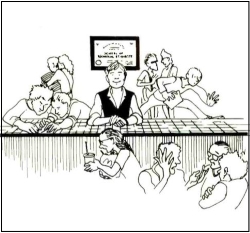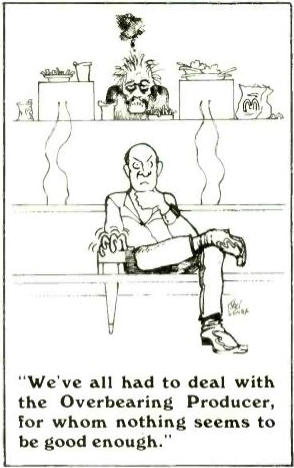
So, Let’s Get Metaphysical and get-down-with-the-mellow-sound of:
Tact Factor Axiom #1
The incidence of inter-personal hassles in any given situation is inversely proportional to the clarity of delineation of the pecking order in that situation; and (to lesser extent) the experience level of the parties involved.
The (Wo)Man In The Middle
The brave engineer’s role ain’t always so easy. You have to answer to everyone: the studio, the producer, the artist(s), the money people, the Company people, the promotional people, the hang-arounds, the hangers-on, the great, the near-great and the think-they’re-great; your own business /professional sense, your own creative head and, above all, your own conscience. Not to mention your lover ( “Sorry babe, looks like the session’s gonna run long . . . again”).
There’s such a difference between the way an instrument sounds to the ear and to a microphone/loudspeaker – even without all our toys – that engineers generally are regarded as practitioners of (relatively benign) black magic. As such, we’re called upon to explain the whys and wherefores, and alleviate, circumvent, and otherwise nullify the fears of the uninitiated. (Sounds like The Wizard of Oz, no ?)
And, to make matters worse, we usually have to mediate those lovable, laughable Control-Room-Differences-Of-Opinion, and, while doing so, manage to save the honor of all the above mentioned individuals. Tall order.
If you are not the producer (but just the engineer) and /or the Boss is present, your main mediation job is to present the range of options in any given situation: “I can make the vocals `fat’ and `churchy’ with this mike and EQ, or `light’ and `floating’ with that combination.” You don’t have to stick to technical terms, but you must know exactly where you stand before venturing too far into the great Gray Area of musical suggestions.
Usually, there are too many conflicting creative viewpoints on any particular session as it is; we should be careful not to add any of our “noise” to the signal path.
Engineers need to think in three languages: the Language of Physics, the Language of Music, and the private dialect of the Native language that all sessions (at least the extended ones) seem to develop. (Some bands definitely speak in their own code, right ?) The design and construction of your console is precise; the “design” of showbiz talk is not. Words mean subtly different things to each of us ( “I hear ya … “), and every word has different personal or mental pictures associated with it. They will want you as their engineer if you “speak their language” or, in the ideal case, if you wear their ears as well as your own.
We all know that bad means something entirely different to an R&B producer than it does to the A&R man from the serious music division, but what does dark mean, and to whom? Where do you stop equalizing for edge, and start EQ’ing for air? Pitch translates fairly as frequency; tone color as timbre. But what about punch?
Thus:
Tact Factor Axiom #2
Your success in a working relationship is governed by your ability to understand and “feel” from everyone else’s position as if it were your own.
Sooner or later (usually sooner) somebody is going to ask you for a musical judgement that you really don’t want to make. If you have excellent control of your voice, and the sincerity of a con man, you can get away with answering the question: “Well, what do you think ?” with such non-polemical responses as: “Powerful!”; “A lot of feeling there … ‘ ; or “I don’t honestly think we can get better than that.”
Most of us are not so gifted or so quick to put our hard-won reputation for honesty at risk. Thus, we’re left with the necessity to duck the issue entirely. If we elect government officials to be professionally good at side-stepping, why can’t we do it ourselves (in the line of duty, of course)?
The best method is to hand it back to them: “Well, why don’t we hold that one and do one more. And you guys can compare them and decide.” This response is not only good for the tape manufacturers, it’s good for the studio; although “running the clock” is an underhanded way to make a buck, and runs the risk of client alienation. (It’s best to have a real good reason for any time-consuming procedure that we do – unless we’re working a spec deal, or something like that). I’m a strong believer in encouraging the artist to make as many of the creative decrees as possible. It usually takes longer that way but the product hangs together better. And it goes a long way towards stopping squabbles in the studio. Any tension you can spare the performers is worth going for.

